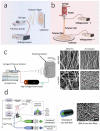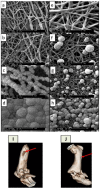Bone Mineralization in Electrospun-Based Bone Tissue Engineering
- PMID: 35632005
- PMCID: PMC9146582
- DOI: 10.3390/polym14102123
Bone Mineralization in Electrospun-Based Bone Tissue Engineering
Abstract
Increasing the demand for bone substitutes in the management of bone fractures, including osteoporotic fractures, makes bone tissue engineering (BTE) an ideal strategy for solving the constant shortage of bone grafts. Electrospun-based scaffolds have gained popularity in BTE because of their unique features, such as high porosity, a large surface-area-to-volume ratio, and their structural similarity to the native bone extracellular matrix (ECM). To imitate native bone mineralization through which bone minerals are deposited onto the bone matrix, a simple but robust post-treatment using a simulated body fluid (SBF) has been employed, thereby improving the osteogenic potential of these synthetic bone grafts. This study highlights recent electrospinning technologies that are helpful in creating more bone-like scaffolds, and addresses the progress of SBF development. Biomineralized electrospun bone scaffolds are also reviewed, based on the importance of bone mineralization in bone regeneration. This review summarizes the potential of SBF treatments for conferring the biphasic features of native bone ECM architectures onto electrospun-based bone scaffolds.
Keywords: bone mineralization; bone tissue engineering; electrospinning; simulated body fluid.
Conflict of interest statement
The author declares no conflict of interest.
Figures





Similar articles
-
Nanofibrous Mineralized Electrospun Scaffold as a Substrate for Bone Tissue Regeneration.J Biomed Nanotechnol. 2016 Nov;12(11):2076-82. doi: 10.1166/jbn.2016.2306. J Biomed Nanotechnol. 2016. PMID: 29364624
-
Cross-Linking Agents for Electrospinning-Based Bone Tissue Engineering.Int J Mol Sci. 2022 May 13;23(10):5444. doi: 10.3390/ijms23105444. Int J Mol Sci. 2022. PMID: 35628254 Free PMC article. Review.
-
Recent Advancements in Electrospun Chitin and Chitosan Nanofibers for Bone Tissue Engineering Applications.J Funct Biomater. 2023 May 22;14(5):288. doi: 10.3390/jfb14050288. J Funct Biomater. 2023. PMID: 37233398 Free PMC article. Review.
-
Processing nanoengineered scaffolds through electrospinning and mineralization suitable for biomimetic bone tissue engineering.J Mech Behav Biomed Mater. 2008 Jul;1(3):252-60. doi: 10.1016/j.jmbbm.2008.01.007. Epub 2008 Feb 15. J Mech Behav Biomed Mater. 2008. PMID: 19627790
-
Calcium phosphate deposition rate, structure and osteoconductivity on electrospun poly(l-lactic acid) matrix using electrodeposition or simulated body fluid incubation.Acta Biomater. 2014 Jan;10(1):419-27. doi: 10.1016/j.actbio.2013.08.041. Epub 2013 Sep 5. Acta Biomater. 2014. PMID: 24012605 Free PMC article.
Cited by
-
Study on Filtration Performance of PVDF/PUL Composite Air Filtration Membrane Based on Far-Field Electrospinning.Polymers (Basel). 2022 Aug 12;14(16):3294. doi: 10.3390/polym14163294. Polymers (Basel). 2022. PMID: 36015550 Free PMC article.
-
Simultaneous Coating of Electrospun Nanofibers with Bioactive Molecules for Stem Cell Osteogenesis In Vitro.Cell J. 2024 Feb 1;26(2):130-138. doi: 10.22074/cellj.2024.2008921.1388. Cell J. 2024. PMID: 38459730 Free PMC article.
-
A Review of 3D Polymeric Scaffolds for Bone Tissue Engineering: Principles, Fabrication Techniques, Immunomodulatory Roles, and Challenges.Bioengineering (Basel). 2023 Feb 3;10(2):204. doi: 10.3390/bioengineering10020204. Bioengineering (Basel). 2023. PMID: 36829698 Free PMC article. Review.
-
Electrospun Poly(L-lactide-co-ε-caprolactone) Nanofibers with Hydroxyapatite Nanoparticles Mimic Cellular Interplay in Bone Regeneration.Int J Mol Sci. 2025 Jun 4;26(11):5383. doi: 10.3390/ijms26115383. Int J Mol Sci. 2025. PMID: 40508197 Free PMC article.
-
Chitosan-Based Scaffolds for Facilitated Endogenous Bone Re-Generation.Pharmaceuticals (Basel). 2022 Aug 19;15(8):1023. doi: 10.3390/ph15081023. Pharmaceuticals (Basel). 2022. PMID: 36015171 Free PMC article. Review.
References
Publication types
Grants and funding
LinkOut - more resources
Full Text Sources

